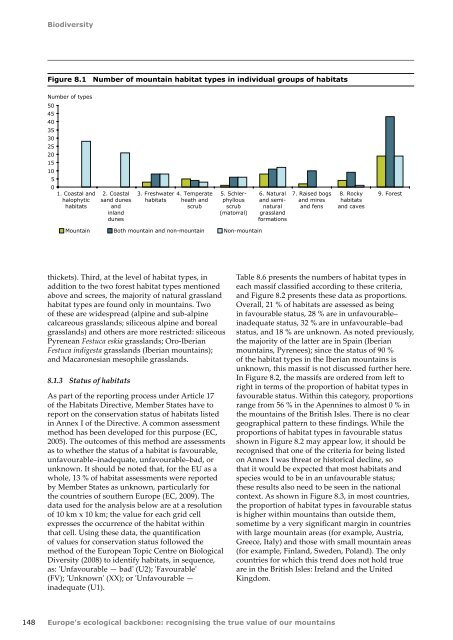Europes ecological backbone.pdf
Europes ecological backbone.pdf
Europes ecological backbone.pdf
Create successful ePaper yourself
Turn your PDF publications into a flip-book with our unique Google optimized e-Paper software.
Biodiversity<br />
Figure 8.1 Number of mountain habitat types in individual groups of habitats<br />
Number of types<br />
50<br />
45<br />
40<br />
35<br />
30<br />
25<br />
20<br />
15<br />
10<br />
5<br />
0<br />
1. Coastal and<br />
halophytic<br />
habitats<br />
2. Coastal<br />
sand dunes<br />
and<br />
inland<br />
dunes<br />
3. Freshwater<br />
habitats<br />
4. Temperate<br />
heath and<br />
scrub<br />
5. Schlerphyllous<br />
scrub<br />
(matorral)<br />
6. Natural<br />
and seminatural<br />
grassland<br />
formations<br />
7. Raised bogs<br />
and mires<br />
and fens<br />
8. Rocky<br />
habitats<br />
and caves<br />
9. Forest<br />
Mountain Both mountain and non-mountain Non-mountain<br />
thickets). Third, at the level of habitat types, in<br />
addition to the two forest habitat types mentioned<br />
above and screes, the majority of natural grassland<br />
habitat types are found only in mountains. Two<br />
of these are widespread (alpine and sub-alpine<br />
calcareous grasslands; siliceous alpine and boreal<br />
grasslands) and others are more restricted: siliceous<br />
Pyrenean Festuca eskia grasslands; Oro-Iberian<br />
Festuca indigesta grasslands (Iberian mountains);<br />
and Macaronesian mesophile grasslands.<br />
8.1.3 Status of habitats<br />
As part of the reporting process under Article 17<br />
of the Habitats Directive, Member States have to<br />
report on the conservation status of habitats listed<br />
in Annex I of the Directive. A common assessment<br />
method has been developed for this purpose (EC,<br />
2005). The outcomes of this method are assessments<br />
as to whether the status of a habitat is favourable,<br />
unfavourable–inadequate, unfavourable–bad, or<br />
unknown. It should be noted that, for the EU as a<br />
whole, 13 % of habitat assessments were reported<br />
by Member States as unknown, particularly for<br />
the countries of southern Europe (EC, 2009). The<br />
data used for the analysis below are at a resolution<br />
of 10 km x 10 km; the value for each grid cell<br />
expresses the occurrence of the habitat within<br />
that cell. Using these data, the quantification<br />
of values for conservation status followed the<br />
method of the European Topic Centre on Biological<br />
Diversity (2008) to identify habitats, in sequence,<br />
as: 'Unfavourable — bad' (U2); 'Favourable'<br />
(FV); 'Unknown' (XX); or 'Unfavourable —<br />
inadequate (U1).<br />
Table 8.6 presents the numbers of habitat types in<br />
each massif classified according to these criteria,<br />
and Figure 8.2 presents these data as proportions.<br />
Overall, 21 % of habitats are assessed as being<br />
in favourable status, 28 % are in unfavourable–<br />
inadequate status, 32 % are in unfavourable–bad<br />
status, and 18 % are unknown. As noted previously,<br />
the majority of the latter are in Spain (Iberian<br />
mountains, Pyrenees); since the status of 90 %<br />
of the habitat types in the Iberian mountains is<br />
unknown, this massif is not discussed further here.<br />
In Figure 8.2, the massifs are ordered from left to<br />
right in terms of the proportion of habitat types in<br />
favourable status. Within this category, proportions<br />
range from 56 % in the Apennines to almost 0 % in<br />
the mountains of the British Isles. There is no clear<br />
geographical pattern to these findings. While the<br />
proportions of habitat types in favourable status<br />
shown in Figure 8.2 may appear low, it should be<br />
recognised that one of the criteria for being listed<br />
on Annex I was threat or historical decline, so<br />
that it would be expected that most habitats and<br />
species would to be in an unfavourable status;<br />
these results also need to be seen in the national<br />
context. As shown in Figure 8.3, in most countries,<br />
the proportion of habitat types in favourable status<br />
is higher within mountains than outside them,<br />
sometime by a very significant margin in countries<br />
with large mountain areas (for example, Austria,<br />
Greece, Italy) and those with small mountain areas<br />
(for example, Finland, Sweden, Poland). The only<br />
countries for which this trend does not hold true<br />
are in the British Isles: Ireland and the United<br />
Kingdom.<br />
148 Europe's <strong>ecological</strong> <strong>backbone</strong>: recognising the true value of our mountains

















